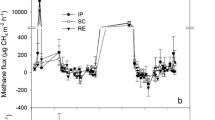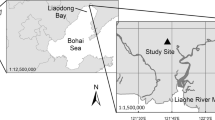Abstract
Rates of CO2 emission from bare salt-marsh sediments in areas of short and tall formSpartina alterniflora were measured monthly for 1 yr. Maximum emission rates, as high as 325 ml CO2m−2h−1, were observed during summer months, while minimum rates, 10.2 ml CO2 m−2h−1, were observed during the winter. An exponential function of inverse soil temperature explained most of the seasonal variability, but other factors are involved in regulating CO2 emissions as demonstrated by rates that were higher in spring than in late summer at equivalent temperatures. Annual CO2 emissions from bare sediments were 27.3 and 18.6 mol C m−2 yr−1 in communities of short and tallS. alterniflora, respectively. It was estimated that losses of dissolved inorganic carbon from the turnover of pore water, up to 14.6 mol C m−2 yr−1 at the creek bank (tall,S. alterniflora) site, and diffusion of CO2 from the root system ofS. alterniflora through the culms, 12.3 to 16.2 mol C m−2 yr−1, could also be important pathways of carbon loss from marsh sediments. If the internal flux of CO2 from the root system through the culm is refixed within the leaves, then the observed rate of 9.8 μI CO2 min−1 cm−2 of culm cross sectional area appears to make a small but significant contribution to total photosynthesis.
Similar content being viewed by others

Literature Cited
Blum, U., E. D. Seneca, andL. M. Stroud. 1978. Photosynthesis and respiration ofSpartina andJuncus salt marshes in North Carolina: some models.Estuaries 1:228–238.
Bollinger, M. S., andW. S. Moore. 1984. Radium fluxes from a salt marsh.Nature 309:444–446.
Chapman V. J. 1938. Studies in salt-marsh ecology.J. Ecol. 26:144–179.
Chrzanowski, T. H., L. H. Stevenson, andJ. D. Spurrier. 1983. Transport of dissolved organic carbon through a major creek of the North Inlet ecosystem.Mar. Ecol. Prog. Ser. 13:167–174.
De La Cruz, A. A. 1973. The role of tidal marshes in the productivity of coastal waters.Assoc. Southeastern Biologists Bull. 20:147–156.
Drake, B. G., andM. Read. 1981. Carbon dioxide assimilation, photosynthetic efficiency, and respiration of a Chesapeake Bay salt marsh.J. Ecol. 69: 405–423.
Fenchel, T., andT. H. Blackburn. 1979. Bacteria and Mineral Cycling. Academic Press, New York, 225 p.
Gardner, L. R. 1973. The effect of hydrologic factor on the pore water chemistry of intertidal marsh sediments.Southeat Geol. 15:17–28.
Gallagher, J. L., andF. G. Plumley. 1979. Underground biomass profiles and productivity in Atlantic coastal marshes.Am. J. Bot. 66:156–161.
Giurgevich, J. R., andE. L. Dunn. 1982. Seasonal patterns of daily net photosynthesis, transpiration and net primary productivity ofJuncus roemerianus andSpartina alterniflora in a Georgia salt marsh.Oecologia 52:404–410.
Gleason, M. L., andE. L. Dunn. 1982. Effects of hypoxia on root and shoot respiration ofSpartina alterniflora, p. 243–253.In V. S. Kennedy (ed.), Estuarine Comparisons. Academic Press, New York.
Good, R. E., N. F. Good, andB. R. Frasco. 1982. A review of primary production and decomposition dynamics of the belowground marsh component, p. 139–157.In V. S. Kennedy (ed.), Estuarine Comparisons. Academic Press, New York.
Hackney, C. T., andA. A. De la Cruz. 1980. In situ decomposition of roots and rhizomes of two tidal marsh plants.Ecology 61:226–231.
Hartenstein, R. 1972. Principles of Physiology. Van Nostrand Reinhold, New York, 691 p.
Higuchi, T. 1982. Gaseous CO2 transport through the aerenchyma and intercellular spaces in relation to the uptake of CO2 by rice roots.Soil Sci. Plant Nutr. 28:491–497.
Higuchi, T., K. Yoda, andK. Tensho. 1984. Further evidence for gaseous CO2 transport in relation to root uptake of CO2 in rice plant.Soil Sci. Plant Nutr. 30:125–136.
Houghton, R. A., andG. M. Woodwell. 1980. The Flax Pond ecosystem study: exchanges of CO2 between a salt marsh and the atmosphere.Ecology 61: 1434–1445.
Howes, B. L., J. W. H. Dacey, andJ. M. Teal 1985. Annual carbon mineralization and below-ground production ofSpartina alterniflora in a New England salt marsh.Ecology 66:595–605.
Howes, B. L., R. W. Howarth, J. M. Teal, andI. Valiela. 1981. Oxidation-reduction potentials in a salt marsh: spatial patterns and interactions with primary production.Limnol. Oceanogr. 26:350–360.
Kepkay, P. E., andF. O. Andersen. 1985. Aerobic and anaerobic metabolism of a sediment enriched withSpartina detritus.Mar. Ecol. Prog. Ser. 21:153–161.
Kjereve, B., J. E. Greer, andR. L. Crout. 1973. Low frequency response of estuarine sea level to non-local forcing p. 477–513.In M. L. Wiley (ed.), Estuarine Interactions. Academic Press, New York.
Mendelssohn, I. A., andE. D. Seneca. 1980. The influence of soil drainage on the growth of salt marsh cordgrassSpartina alterniflora in North Carolina.Estuarine Coastal Mar. Sci. 11:27–40.
Morris, J. T., andJ. W. H. Dacey. 1984. Effects of O2 on ammonium uptake and root respiration bySpartina alterniflora.Am. J. Bot. 71:979–985.
Morris, J. T., andG. J. Whiting. 1985. Gas advection in sediments of a South Carolina salt marsh.Mar. Ecol. Prog. Ser. 27:187–194.
Nobel, P. S. 1983. Biophysical Plant Physiology and Ecology. Freeman, San Francisco, 608 p.
Sas Institute Inc. 1982. SAS User’s Guide: Statistics. SAS Institute Inc., Cary, NC, 584 p.
Singh, J. S., W. K. Lauenroth, H. W. Hunt, andD. M. Swift. 1984. Bias and random errors in estimators of net root production: a simulation approach.Ecology 65:1760–1764.
Smith, C. J., R. D. Delaune, andW. H. Patrick, Jr. 1983. Carbon dioxide emission and carbon accumulation in coastal wetlands.Estuarine Coastal Shelf Sci. 17:21–29.
Teal, J. M. 1962. Energy flow in the salt marsh ecosystem of Georgia.Ecology 43:614–624.
Teal, J. M., andJ. Kanwisher. 1961. Gas exchange in a Georgia salt marsh.Limnol. Oceanogr. 6:388–399.
Valiela, I., J. Wilson, R. Buchsbaum, C. Rietsma, D. Bryant, K. Foreman andJ. Teal. 1984. Importance of chemical composition of salt marsh litter on decay rates and feeding by detritivores.Bull. Mar. Sci. 35:261–269.
Wetzel, R. G., E. S. Brammer, andC. Forsberg. 1984. Photosynthesis of submersed macrophytes in acidified lakes. I. Carbon fluxes and recycling of CO2 inJuncus bulbosus L.Aquat. Bot. 19:329–342.
Woodwell, G. M., D. E. Whitney, C. A. S. Hall, andR. A. Houghton. 1977. The Flax Pond ecosystem study: exchanges of carbon in water between a salt marsh and Long Island Sound.Limnol. Oceanogr. 22:833–838.
Author information
Authors and Affiliations
Rights and permissions
About this article
Cite this article
Morris, J.T., Whiting, G.J. Emission of gaseous carbon dioxide from salt-marsh sediments and its relation to other carbon losses. Estuaries 9, 9–19 (1986). https://doi.org/10.2307/1352188
Received:
Accepted:
Issue Date:
DOI: https://doi.org/10.2307/1352188



